Introduction
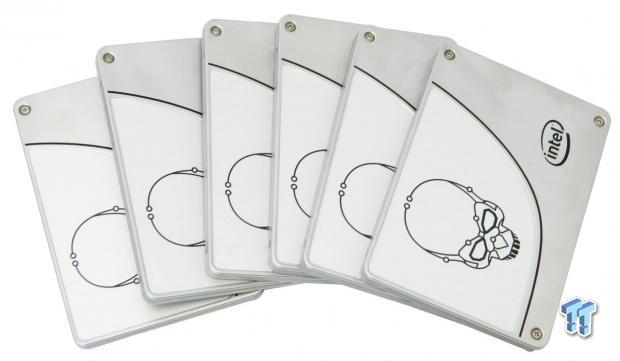
Intel's 730 is specifically designed for enthusiasts. Intel took their excellent performing DC S3500 Data Center SSD and adapted it for the enthusiast sector. The 730 series retains the DC S3500's enterprise DNA and gets a big performance boost from a factory overclocked processor and overclocked flash.
Like most overclocked pieces of hardware, the 730 runs hot, fast, and uses a lot of power; just the way we enthusiast's like it. Intel vigorously validates their SSD's with the industry's most extensive testing regimen and as such, Intel can deliver an overclocked solid state drive that not only outperforms the competition, but also is more reliable than the competition.
During our first go-round with a 730 array we quickly discovered that the real magic of the 730 is that it scales better in RAID than any SSD we've tested to date. A single 730 can be outperformed by some SSD's, but not a 730 RAID array. Enterprise SSD's are designed to run in RAID where scaling becomes very important, and the 730 is based on an enterprise SSD. This is exactly what we mean by the term enterprise DNA.
We are starting to see many new PCIe drives hit the market. PCIe drives are designed to replace SATA based SSD's like the 730. PCIe isn't hampered in the same way SATA is, PCIe has much more bandwidth and lower latency than SATA. PCIe drives are advertised as being faster than SATA based SSD's delivering sequential performance of up to 2000MB/s. This is much faster than SATA; current SATA 6Gb/s is capped at about 550MB/s sequential speeds. When you see 2000MB/s verses 550MB/s speed it's only logical to assume that a PCIe SSD is going to deliver better performance.
As we find so many times though, there is a lot more to the story when we dig a little deeper. Sequential performance is what you want if you plan on utilizing your SSD for a secondary attached device, but that's not what most of the world is going to utilize their expensive SSD's for, we are going to use them for our operating systems, our boot drives. When it comes to operating system storage devices, sequential performance is relatively unimportant, what matters is random performance. PCIe SSD's deliver great sequential performance, but SATA based SSD's typically have superior random performance.
This is where RAID comes into play, and why right now SATA based RAID is an enthusiast's best friend. Random performance "scales" (increases as drives are added to the array) on SATA based arrays, typically a PCIe drives random performance does not scale. In an OS environment a 2 or more drive SATA based array can deliver better performance than any PCIe drive on the market today, and do so for a lower cost per GB. Take a quick look at the chart below to see what we mean:
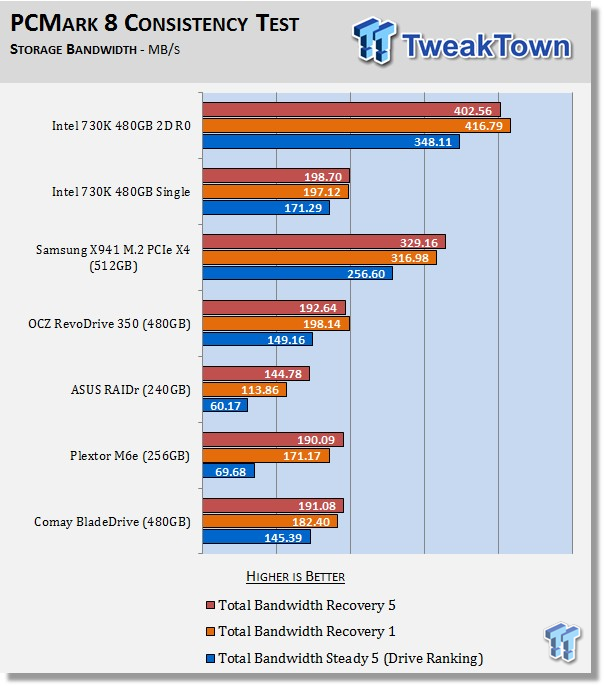
The only PCIe drive on our chart that performs well in an OS environment is Samsung's X941 M.2 X4 SSD and it costs $1.50 per gigabyte. Other drives like OCZ's Revo 350 costing two dollars per gigabyte or more, and boasting sequential performance of 2000 MB/s cannot even beat a single Intel 730 in an OS environment. So what happens when you RAID PCIe drives together? They are no longer bootable and random performance does not scale. Some day that will change, but it's going to be awhile before a PCIe drive is a better choice than a SATA array in an OS setting.
Enthusiasts are defined by their desire to have the best performing hardware available. The best performing hardware does not come cheap; it is going to cost you to be the king of the hill. When you are an enthusiast cost becomes a secondary consideration, performance is your primary consideration. Intel's 730 is on the upper end of the price per gigabyte spectrum for SATA based SSD's coming in at just under a dollar per gigabyte. When you consider the massive performance you get for that dollar per gigabyte, its money well spent in my opinion.
Today we are going to explore what kind of performance Intel's mighty 730 is capable of delivering, and examine how performance scales as we go from a single SSD all the way to a 6-drive array. We will of course be bandwidth limited by our Z87 Lynx Point Chipset however; the performance we will achieve will leave no doubt in your mind that a 730 array is indeed the ultimate disk for your OS Volume at this moment in time.
PRICING: You can find Intel's 730 (480GB) for sale below. The prices listed are valid at the time of writing but can change at any time. Click the link to see the very latest pricing for the best deal.
United States: The Intel 730 (480GB) retails for $445.00 at Amazon.
Canada: The Intel 730 (480GB) retails for CDN$660.23 at Amazon Canada.
Australia: The Intel 730 (480GB) retails for $638.99 AUD at Mighty Ape Australia.
New Zealand: The Intel 730 (480GB) retails for $689.99 NZD at Mighty Ape NZ.
Specifications, Drive Details, Test System Setup, Drive Properties, Pricing and Availability
Specifications
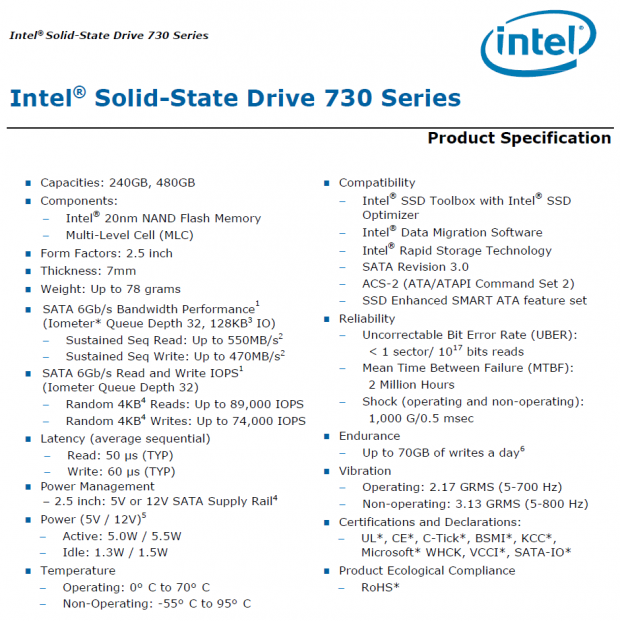
Intel's 730 Series 2.5" SATA III SSD is available in two capacity sizes, 240GB and 480GB. Specifications list the 2.5" 730 Series SSD's as having a bandwidth performance of up to 540MB/s sequential reads and 490MB/s sequential writes. 4KB random read performance is listed at up to 89,000 IOPS and 4KB random write performance is listed at up to 74,000 IOPS.
When you purchase a retail packaged Intel SSD, you not only get a fine product, you get value added features like an accessory kit, Intel's SSD Toolbox as well as Intel's Data Migration Software for easy maintenance and easy drive cloning. Our test drives came in bare OEM packaging but the retail packaged 2.5" 730 ships with an accessory kit that includes SATA power and data cables, a sticker and a software disk. Intel warranties the 730 Series SSD for an industry leading 5 years.
Because this is a RAID review, we are going to focus on performance rather than features. For a more in-depth look at the Intel 730's feature set, I will refer you to Chris Ramseyer's extensive review of Intel's 730 Series SSD.
Drive Details - Intel 730 480GB SSD
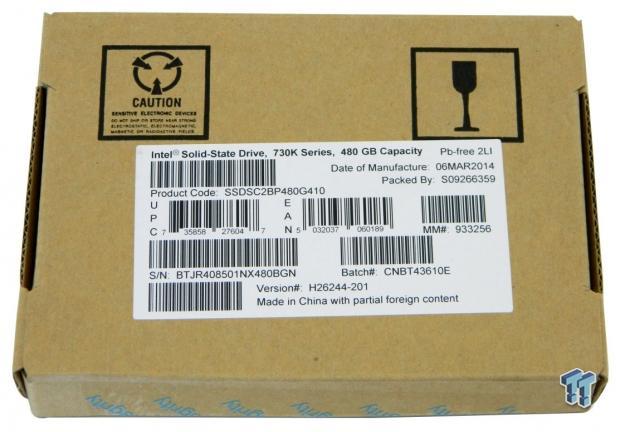
Our drives arrived in plain brown cardboard-boxed OEM packaging. On the top of the box is a manufacturer's sticker that lets us know that our drives are designated 730 series and are 480GB in capacity. The drives date of manufacture is listed along with various product codes, serial number, batch number, etc.
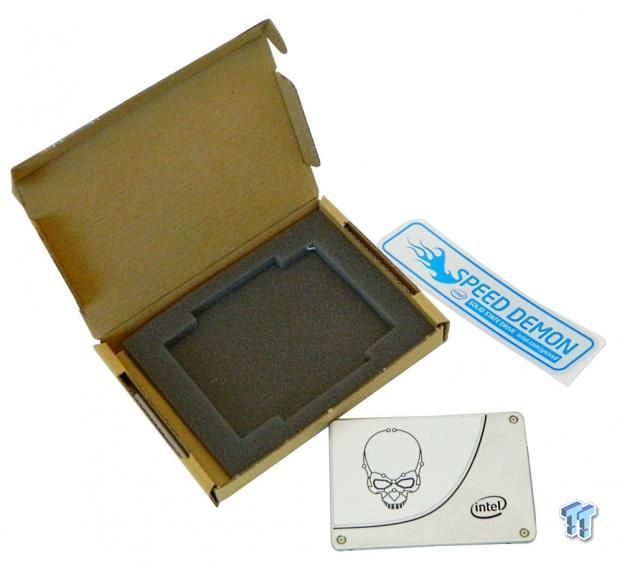
Inside the box, the drive is enclosed in an anti-static envelope that we removed for our photograph. A protective foam insert keeps the drive from sliding around inside the box. Also included is a silver and blue sticker that says "Speed Demon"
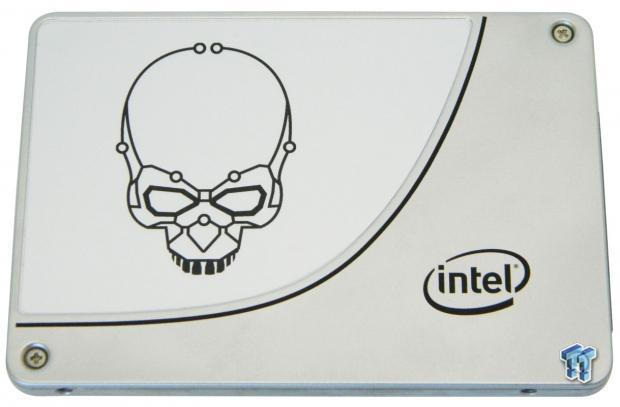
The top of the drives enclosure is formed from a piece of sheet aluminum, natural in color. There is a cool looking white swoosh shaped sticker with a skull emblazoned on it. There are four screws that affix the top of the drives enclosure to bottom and sides of the enclosure. Three of the screws are visible, the fourth is located under the drives swoosh shaped sticker providing evidence of tampering.
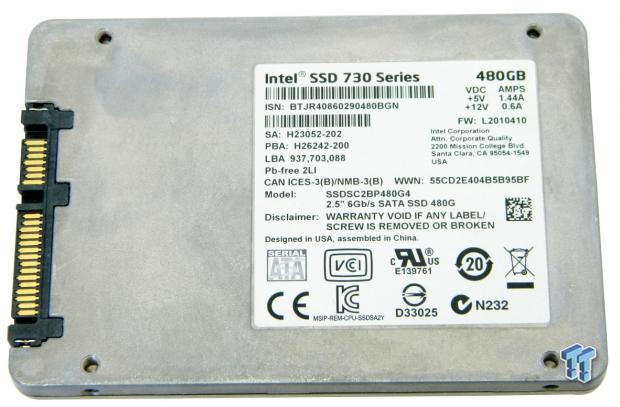
The bottom and sides of the drives enclosure are formed from a single piece of cast aluminum. There is a manufacturer's sticker located on the bottom of the drives enclosure. The sticker lists the drives capacity, shipping firmware, model number, serial number and various other relevant information.
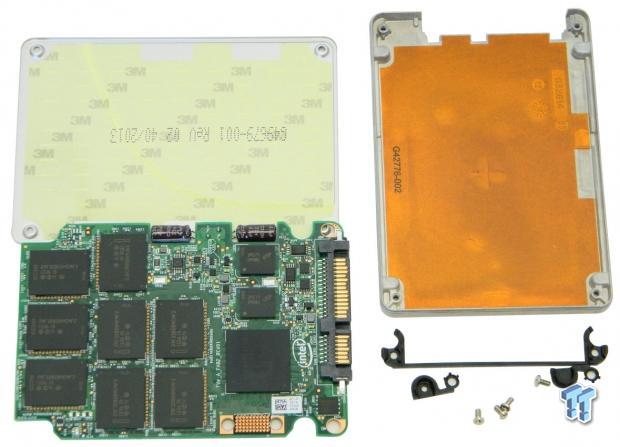
Here's what the drive looks like completely dis-assembled. On this side of the PCB there are (8) Intel branded 20nm BGA NAND packages, 2 DRAM packages, 2 capacitors and an Intel Flash Processor. Both halves of the drives enclosure have what appears to be some sort of Mylar based material affixed to the inside.
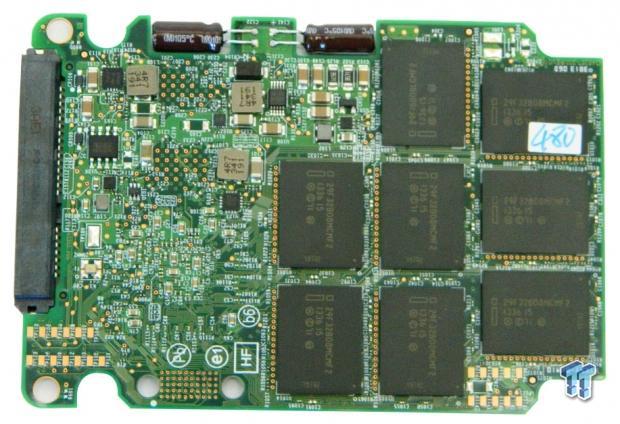
On the opposite side of the PCB are an additional (8) Intel branded 20nm BGA NAND Packages.
Test System Setup
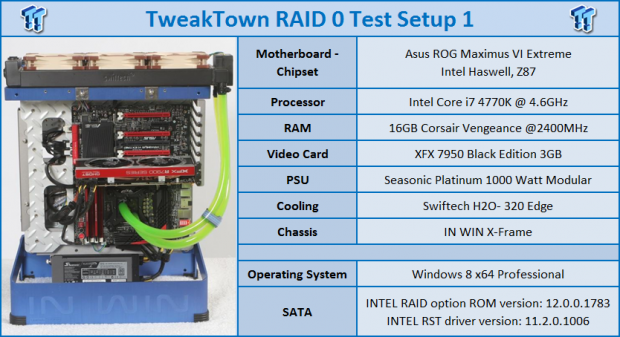
- Drive Properties
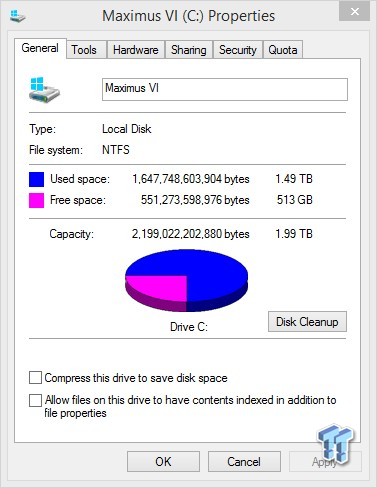
The majority of our testing is performed with our test drive/array as our boot volume. Our boot volume is 75% full for all OS Disk "C" drive testing to mimic a typical consumer OS volume implementation. We are using 64k stripes for our 2-3 drive arrays, 32k stripes for our 4-6 drive arrays. Write caching is enabled, and Windows buffer flushing is disabled.
All of our testing includes charting the performance of a single drive as well as RAID 0 arrays of our test subjects. We are utilizing Windows 8.1 64-bit for all of our testing. We will be posting screen shots of our 6 drive arrays benchmarks.
PRICING: You can find Intel's 730 (480GB) for sale below. The prices listed are valid at the time of writing but can change at any time. Click the link to see the very latest pricing for the best deal.
United States: The Intel 730 (480GB) retails for $445.00 at Amazon.
Canada: The Intel 730 (480GB) retails for CDN$660.23 at Amazon Canada.
Australia: The Intel 730 (480GB) retails for $638.99 AUD at Mighty Ape Australia.
New Zealand: The Intel 730 (480GB) retails for $689.99 NZD at Mighty Ape NZ.
Synthetic Benchmarks - ATTO, Anvil Storage Utilities, CrystalDiskMark & AS SSD
ATTO
Version and / or Patch Used: 2.47
ATTO is a timeless benchmark used to provide manufacturers with data used for marketing storage products.
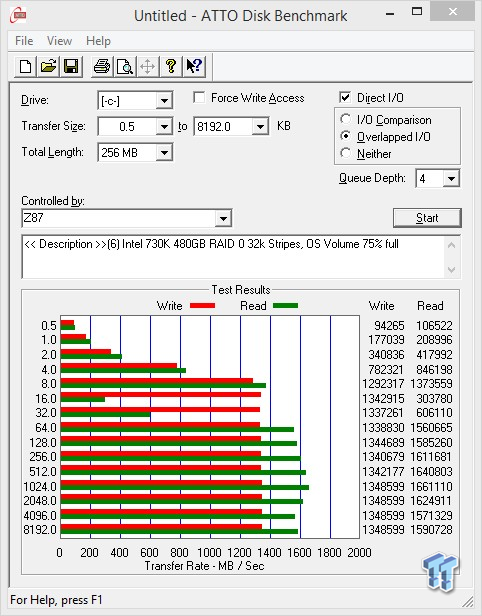
Sequential read transfers max out at 1.584 GB/s. Sequential write transfers max out at 1.286 GB/s. Sequential performance is of course limited by our chipsets bandwidth limitations.
Sequential Write
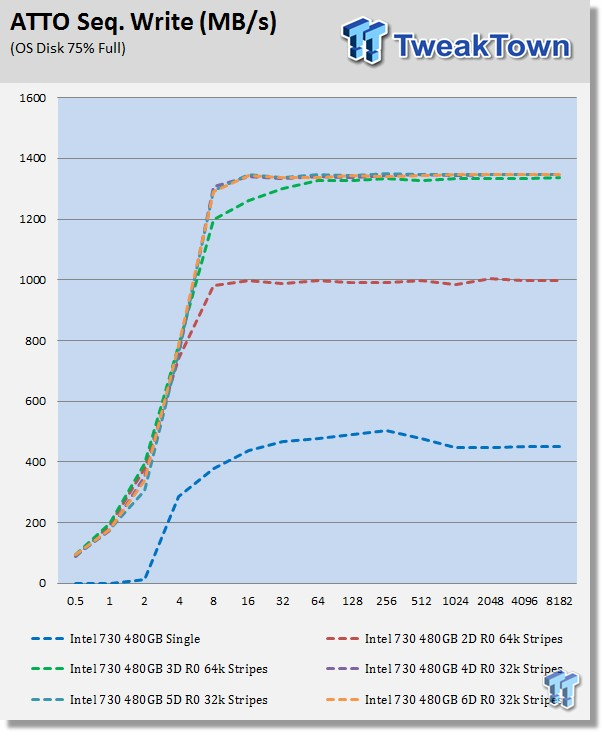
Sequential write transfers max out our Lynx Point Chipset with a 4 drive array.
Sequential Read
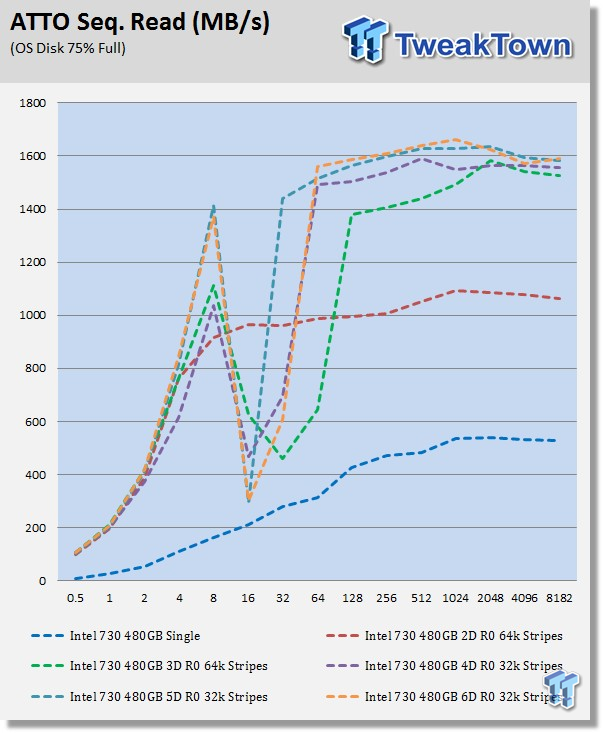
Sequential read transfers scale very well until we hit a 4 drive array, where bandwidth limitations restrict sequential throughput. We do gain performance slightly as we go from a 4 drive array to a 5 and 6 drive array. This test was run with no wait time after filling our arrays to 75% of their capacity. We did not give our 3-6 drive arrays time to settle-in after filling which is why we see a faux performance drop at 16 and 32k transfer sizes.
Anvil Storage Utilities
Version and / or Patch Used: RC6
Anvil's Storage Utilities is a storage benchmark designed to measure the storage performance of SSDs. The Standard Storage Benchmark performs a series of tests; you can run a full test or just the read or write test, or you can run a single test, i.e. 4k QD16.
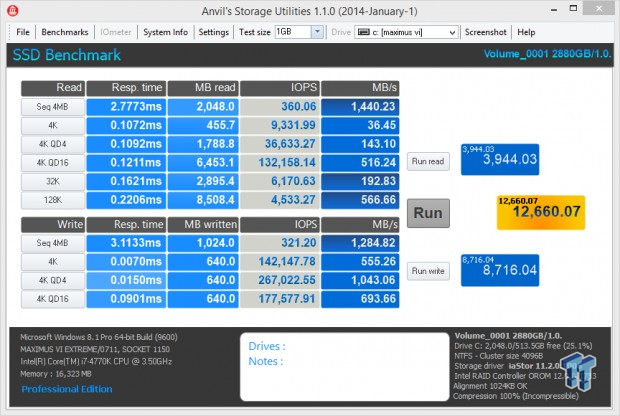
Read scoring is very good; write scoring is limited severely by operating system limitations at high queue depths. You will see what I mean at the end of our testing where we run some benches on an operating that has much better storage performance than Windows 8.1
Read IOPS through Queue Depth Scale
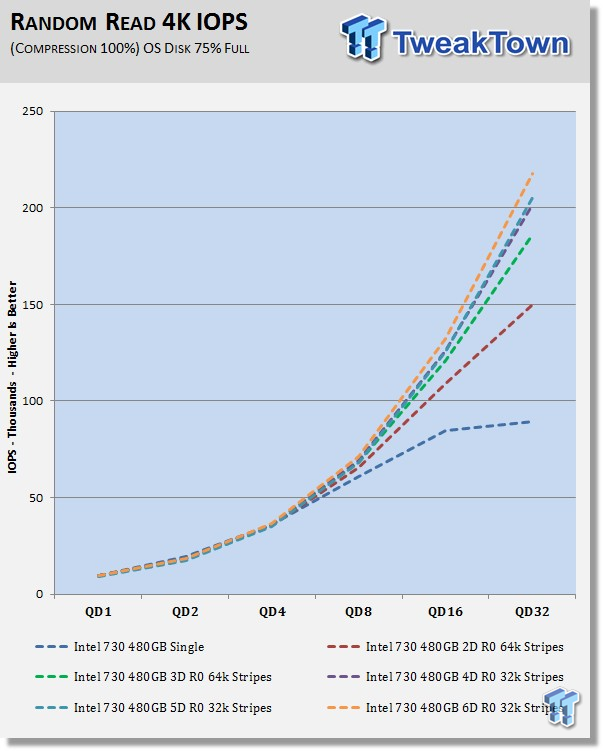
Read performance continues to increase as we add drives to our array, typically we don't see additional performance over 4 drives, but Intel's 730K delivers the highest read IOPS of any SATA based array we've tested to date and delivers increasing performance all the way to 6 drives.
Write IOPS through Queue Scale
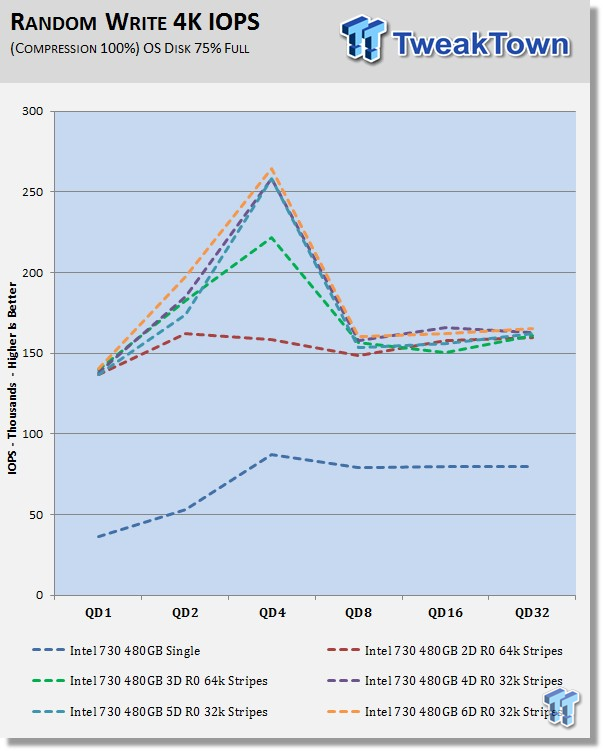
Write performance does increase as we add drives to our array however, Windows 8, 8.1 restricts our arrays IOPS from continuing to climb above QD4 and in-fact causes write IOPS to fall and flatten out at QD8 -QD32. This is not the chipset as you will see, this is the OS.
CrystalDiskMark
Version and / or Patch Used: 3.0 Technical Preview
CrystalDiskMark is disk benchmark software that allows us to benchmark 4k and 4k queue depths with accuracy.
Note: Crystal Disk Mark 3.0 Technical Preview was used for these tests since it offers the ability to measure native command queuing at 4 and 32.
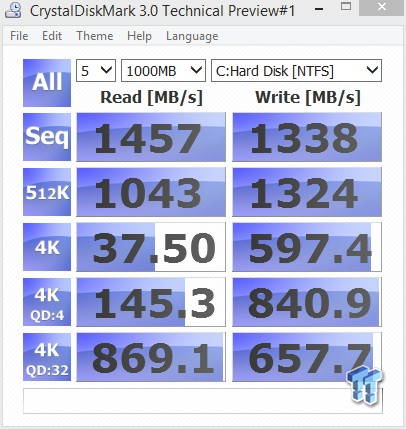
Stunning random performance; even with Windows 8.1. This kind of random write performance is exactly why current PCIe drives are left in the dust by SATA based arrays in an OS environment.
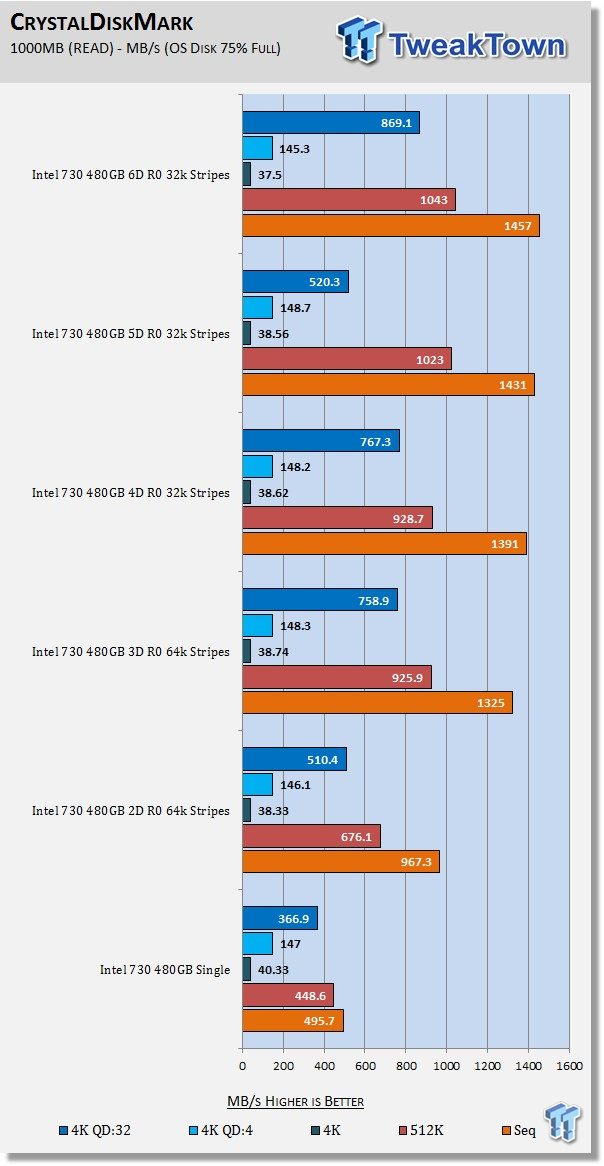
Read performance continues to climb as we add drives to our array. The difference between a 3-drive array and a 6-drive array is bandwidth limited, yet the 730K is able to squeeze in more performance, which we typically don't see from most arrays.
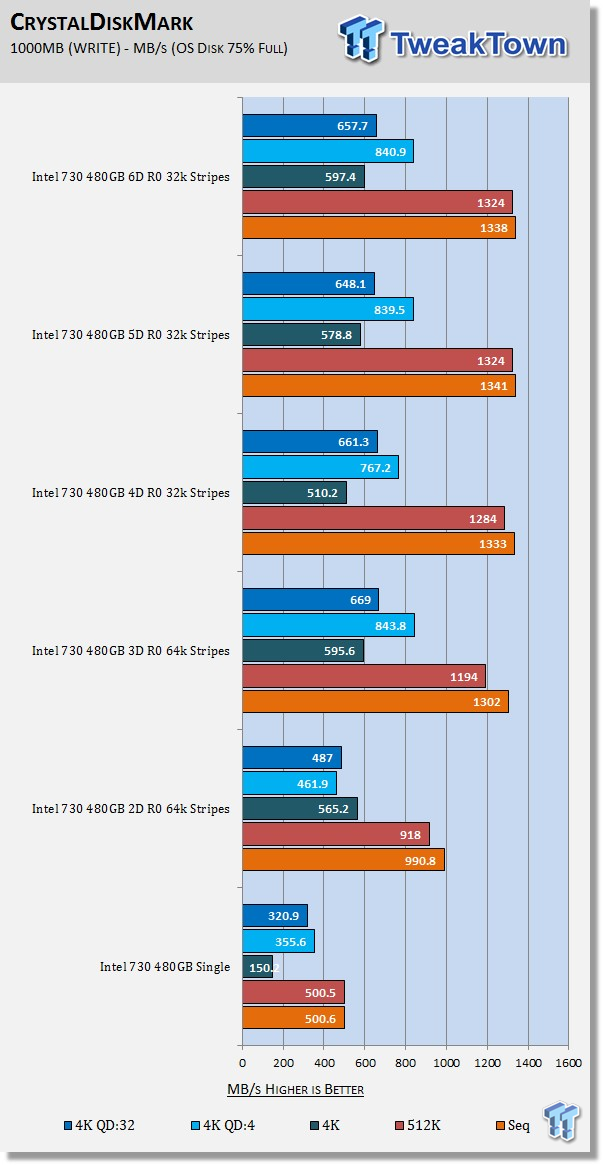
Random write performance is the best we've achieved to date for any SATA array.
AS SSD
Version and / or Patch Used: 1.7.4739.38088
AS SSD determines the performance of Solid-State Drives (SSD). The tool contains four synthetic as well as three practice tests. The synthetic tests are to determine the sequential and random read and write performance of the SSD.
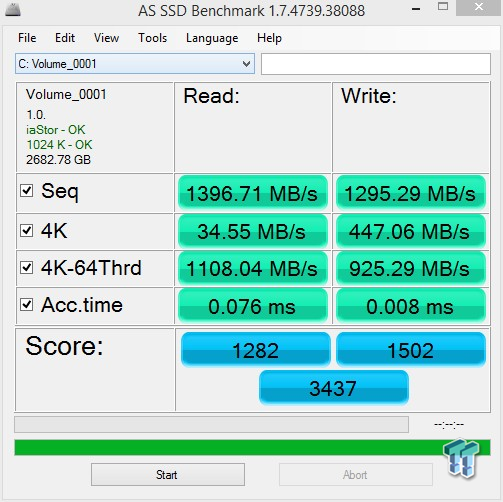
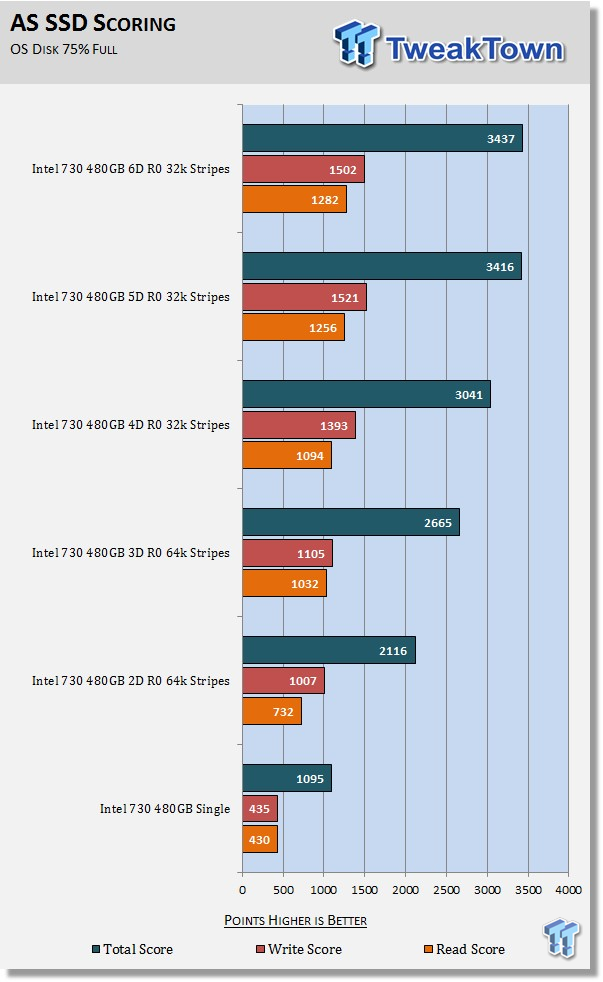
AS SSD reveals a nice performance increase as we add drives to our array. With the last of our synthetic testing completed, let's move to our light usage model testing to give us a better idea of what's under the hood of our 730K arrays in an OS environment.
Benchmarks (Trace Based OS Volume) - PCMark Vantage, PCMark 7 & PCMark 8
Light Usage Model
We are going to categorize these tests as indicative of a light workload. If you utilize your computer for light workloads like browsing the web, checking emails, light gaming, and office related tasks, then this category of results is most relevant for your needs.
PCMark Vantage - Hard Disk Tests
Version and / or Patch Used: 1.2.0.0
The reason we like PCMark Vantage is because the recorded traces are played back without system stops. What we see is the raw performance of the drive. This allows us to see a marked difference between scoring that other trace-based benchmarks do not exhibit. An example of a marked difference in scoring on the same drive would be empty vs. filled vs. steady state.
We run Vantage three ways. The first run is with the OS drive/Array 75% full to simulate a lightly used OS volume filled with data to an amount we feel is common for most users. The second run is with the OS volume written into a "Steady State" utilizing SNIA's guidelines (Rev 1.1). Steady state testing simulates a drive/array's performance similar to that of a drive/array that has been subjected to consumer workloads for extensive amounts of time. The third run is a Vantage HDD test with the test drive/array attached as an empty, lightly used secondary device.
OS Volume 75% Full - Lightly Used
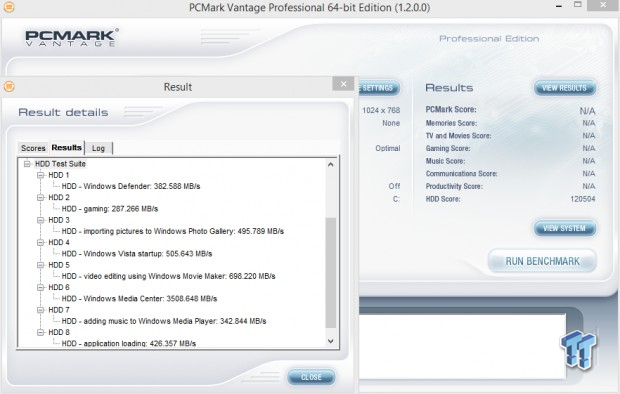
OS Volume 75% Full - Steady State
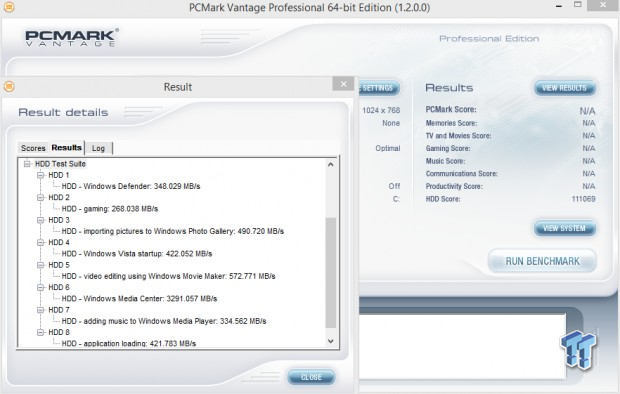
Secondary Volume Empty - Lightly Used
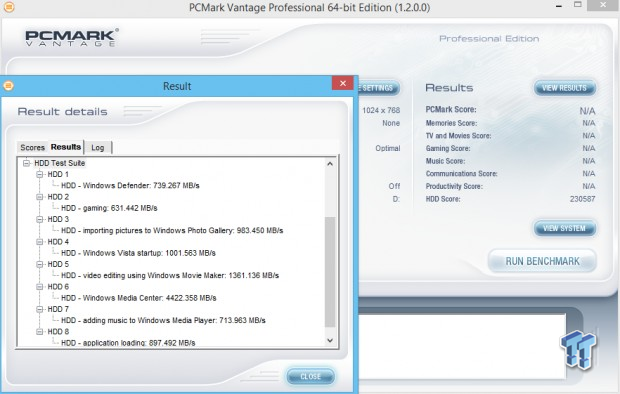
As you can see, there's a big difference between an empty drive/array, one that's 75% full/used, and one that's in a steady state.
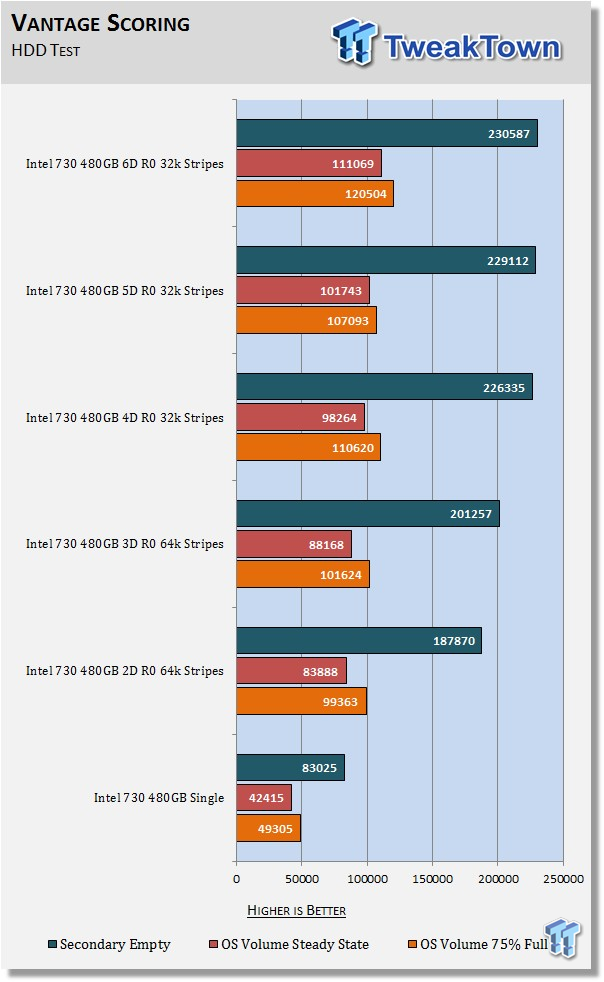
The important scores to pay attention to are "OS Volume Steady State" and "OS Volume 75% full." These two categories are most important because they are indicative of typical of consumer user states.
When a drive/array is in a steady state, it means garbage collection is running at the same time it's reading/writing. This is exactly why we focus on steady state performance. Steady state performance shows that we do indeed get more performance as we add drives to our 730 array.
PCMark 7 - System Storage
Version and / or Patch Used: 1.4.00
We will look to the Raw System Storage scoring for RAID 0 evaluations because it's done without system stops and therefore allows us to see significant scoring differences between drives/arrays.
OS Volume 75% Full - Lightly Used
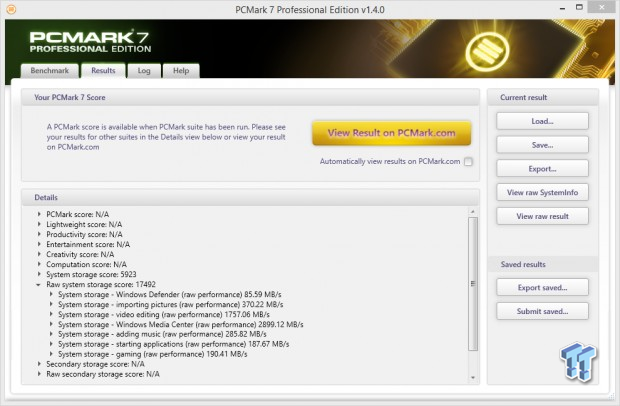

Stripe sizes play an important role in this scenario. If we stayed with 64k stripes, we would not get a performance increase from 3-6 drives. After much testing we've determined that when exceeding 3 drives, 32k stripes deliver superior all-around array performance.
PCMark 8 - Storage Bandwidth
Version and / or Patch Used: 1.2.157
We use the PCMark 8 Storage benchmark to test the performance of SSDs, HDDs, and hybrid drives with traces recorded from Adobe Creative Suite, Microsoft Office, and a selection of popular games. You can test the system drive or any other recognized storage device, including local external drives. Unlike synthetic storage tests, the PCMark 8 Storage benchmark highlights real-world performance differences between storage devices.
OS Volume 75% Full - Lightly Used
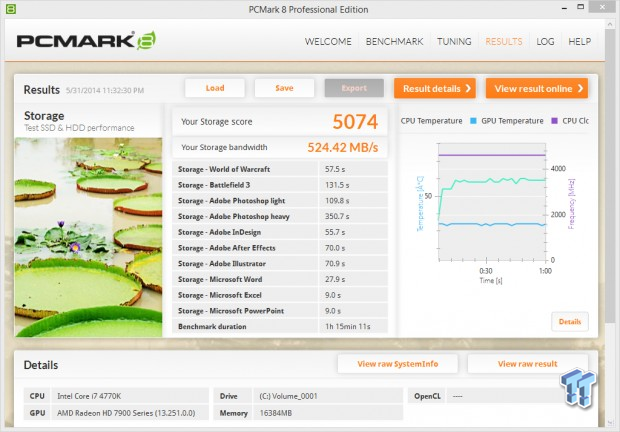
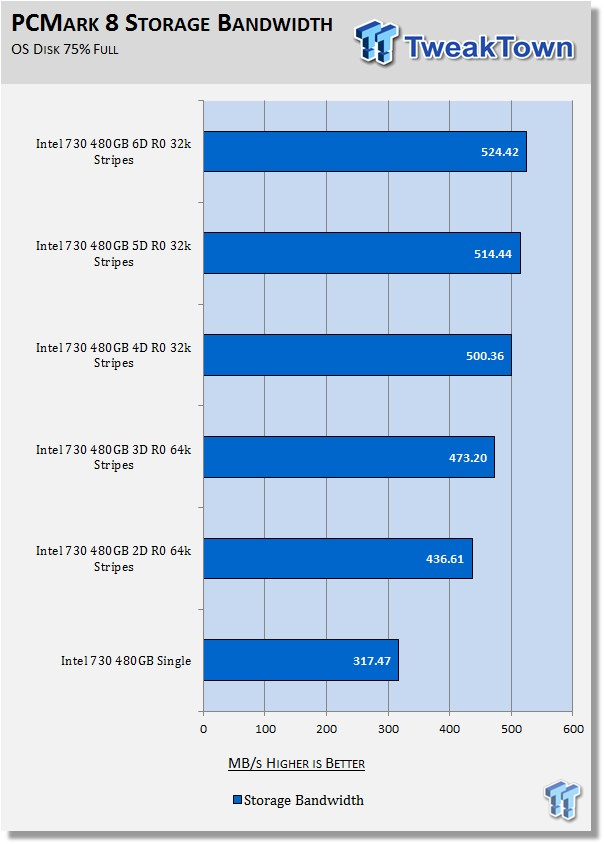
IMFT Flash based arrays dominate this testing. The biggest performance increase is of course when you go from a single drive to a 2-drive array. This is why we love the 730 in RAID. Even though our chipset's bandwidth maximum is limiting sequential performance, our array delivers increasing performance from 3-6 drives. Intel's 730 keeps scaling when other SSD's do not. It's pretty obvious that a single SSD is for average users and a RAID array is essential for enthusiasts.
Benchmarks (Secondary Volume) - Disk Response & Transfer Rates
Iometer - Disk Response
Version and / or Patch Used: 1.1.0
We use Iometer to measure disk response times. Disk response times are measured at an industry accepted standard of 4k QD1 for both write and read. Each test is run twice for 30 seconds consecutively, with a 5 second ramp-up before each test. The drive/array is partitioned and attached as a secondary device for this testing.
Write Response
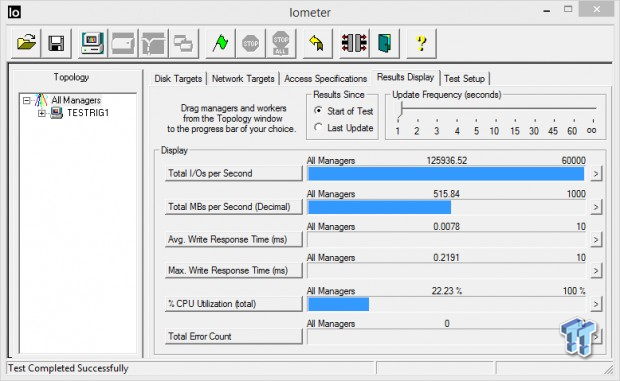
Read Response
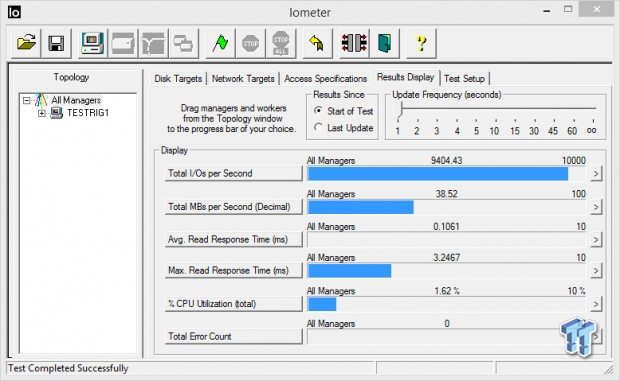
Average Disk Response
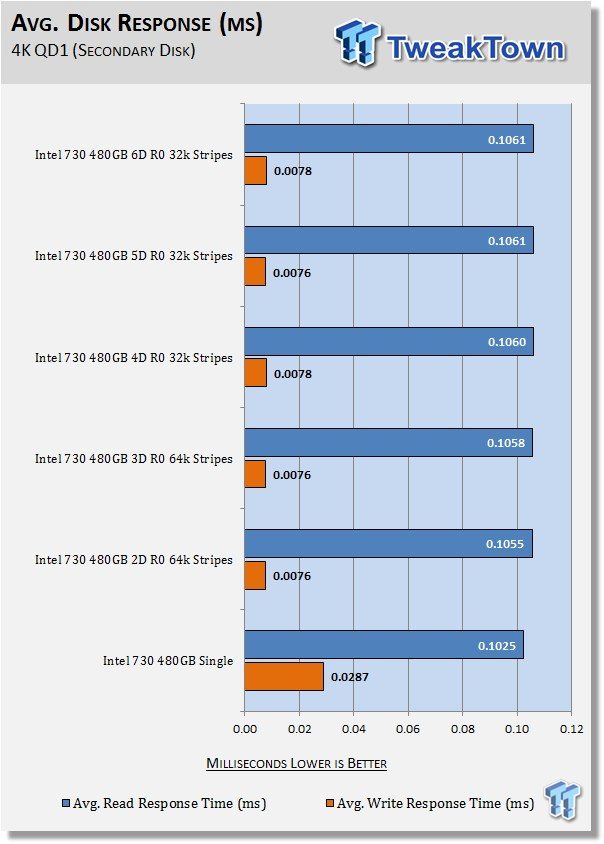
Write response times benefit most from RAID 0 because of write caching. There is a slight latency increase in read response times for an array vs. a single drive.
DiskBench - Directory Copy
Version and / or Patch Used: 2.6.2.0
We use DiskBench to time a 28.6GB block (9,882 files in 1,247 folders) of mostly incompressible random data as it's transferred from our OS array: to our test drive/array. We then read from a 6GB zip file that's part of our 28.6GB data block to determine the test drive/array's read transfer rate. The system is restarted prior to the read test to clear any cached data, ensuring an accurate test result.
Write Transfer Rate
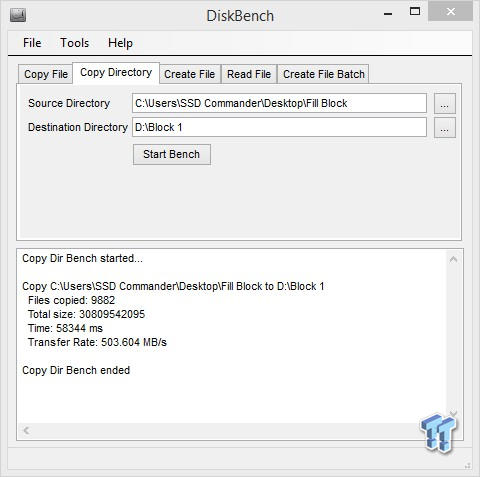
Read Transfer Rate
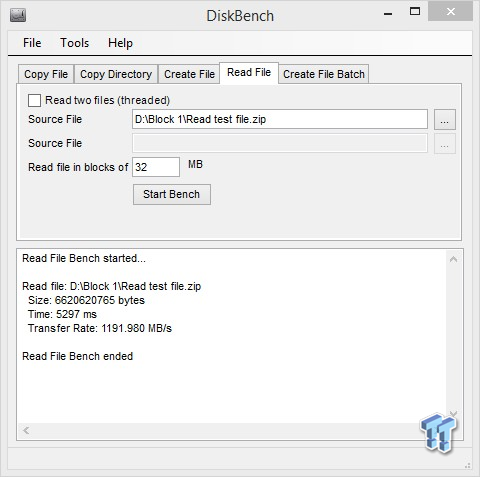
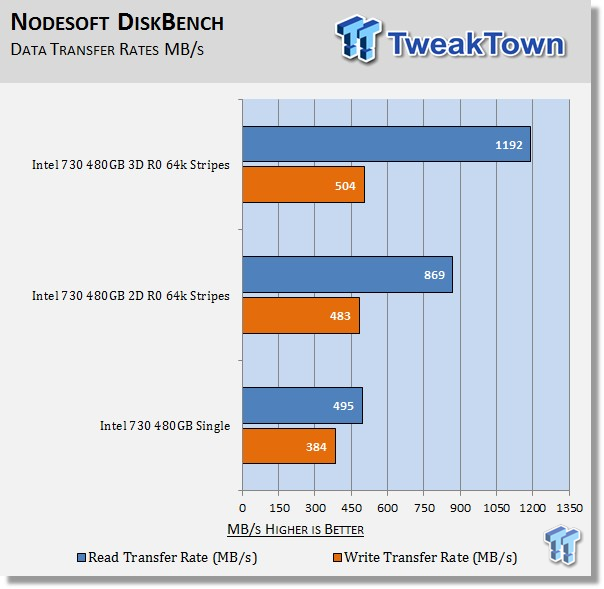
We are only charting transfer up to a three drive array for the simple reason we don't have anything fast enough to feed an array of more than 3 drives. We are transferring data from a 3-drive array to a 3-drive array. Read transfers scale very well, but write transfers are handicapped by SATA architecture's single lane signaling.
Benchmarks (Secondary Volume) - PCMark 8 Extended
Futuremark PCMark 8 Extended - Consistency Test
Heavy Usage Model
We consider PCMark 8's consistency test to be our heavy usage model test. This is the usage model most enthusiasts, heavy duty gamers, and professionals fall into. If you do a lot of gaming, audio/video processing, rendering, or have workloads of this nature, then this test will be most relevant to you.
PCMark 8 has built-in, command line executed storage testing. The PCMark 8 Consistency test measures the performance consistency and the degradation tendency of a storage system.
The Storage test workloads are repeated. Between each repetition, the storage system is bombarded with a usage that causes degraded drive performance. In the first part of the test, the cycle continues until a steady degraded level of performance has been reached. (Steady State)
In the second part, the recovery of the system is tested by allowing the system to idle and measuring the performance with long intervals. (TRIM)
The test reports the performance level at the start, the degraded steady-state, and the recovered state, as well as the number of iterations required to reach the degraded state and the recovered state.
We feel Futuremark's Consistency Test is the best test ever devised to show the true performance of solid state storage in a heavy usage scenario. This test takes on average 13 to 17 hours to complete, and it writes somewhere between 450GB and 13,600GB of test data, depending on the drive(s) being tested. If you want to know what an SSD's performance is going to look like after a few months or years of heavy usage, this test will show you.
Here's a breakdown of Futuremark's Consistency Test:
Precondition phase:
1. Write to the drive sequentially through up to the reported capacity with random data.
2. Write the drive through a second time (to take care of overprovisioning).
Degradation phase:
1. Run writes of random size between 8*512 and 2048*512 bytes on random offsets for 10 minutes.
2. Run performance test (one pass only).
3. Repeat 1 and 2 for 8 times, and on each pass increase the duration of random writes by 5 minutes.
Steady state phase:
1. Run writes of random size between 8*512 and 2048*512 bytes on random offsets for 50 minutes.
2. Run performance test (one pass only).
3. Repeat 1 and 2 for 5 times.
Recovery phase:
1. Idle for 5 minutes.
2. Run performance test (one pass only).
3. Repeat 1 and 2 for 5 times.
Storage Bandwidth
PCMark 8's Consistency test provides a ton of data output that we can use to judge a drive/arrays performance.
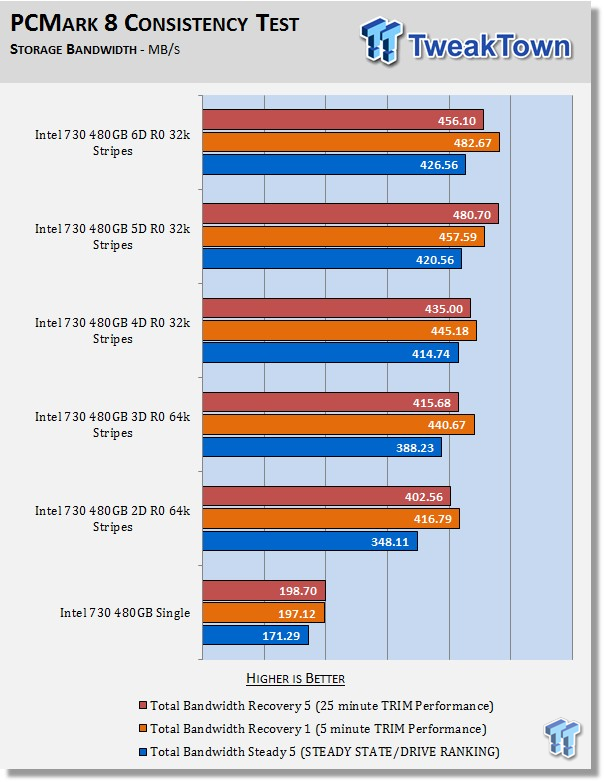
We consider steady state bandwidth (the blue bar) our test that carries the most weight in ranking a drive/arrays performance. The reason we consider steady state performance more important than TRIM is that when you are running a heavy-duty workload, TRIM will not be occurring while that workload is being executed. TRIM performance (the orange and red bars) is what we consider the second most important consideration when ranking a drive/arrays performance. Trace based consistency testing is where true high performing SSDs are separated from the rest of the pack.
This is where we get down to the heart of the matter. Our 730 arrays, despite being bandwidth handicapped, do not max out at 3 drives like most arrays we have tested. A 2-drive 730 array is faster than any other 2-drive SATA array, or PCIe drive in an OS environment to begin with and performance still keeps climbing as we move beyond a 3-drive array.
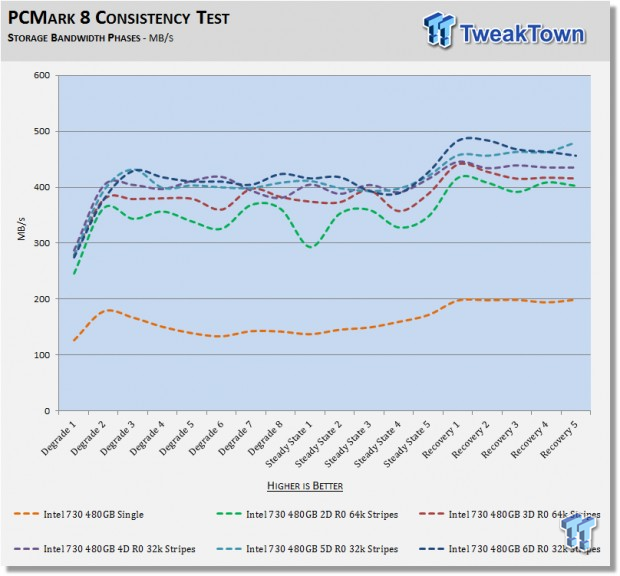
We chart our test subject's storage bandwidth as reported at each of the test's 18 trace iterations. This gives us a good visual perspective of how our test subjects perform as testing progresses.
Total Access Time (Latency)
Access time is the time delay or latency between a request to an electronic system and the access being completed or the requested data returned. Access time is how long it takes to get data back from the disk. We chart the total time the disk is accessed as reported at each of the test's 18 trace iterations.
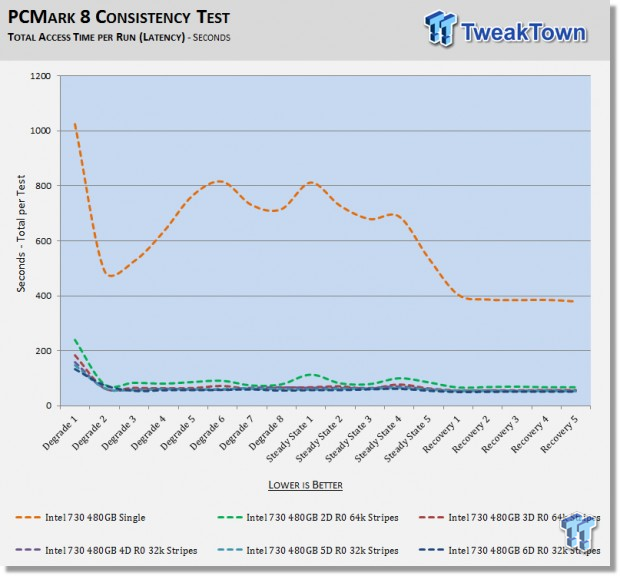
This is a great visual representation of what RAID brings to the table. A single 730 is very fast, but the real magic happens when you RAID 2 or more 730 drives together. The 730's enterprise DNA really shines in RAID.
Disk Busy Time
Disk Busy Time is how long the disk is busy working. We chart the total time the disk is working as reported at each of the tests 18 trace iterations.
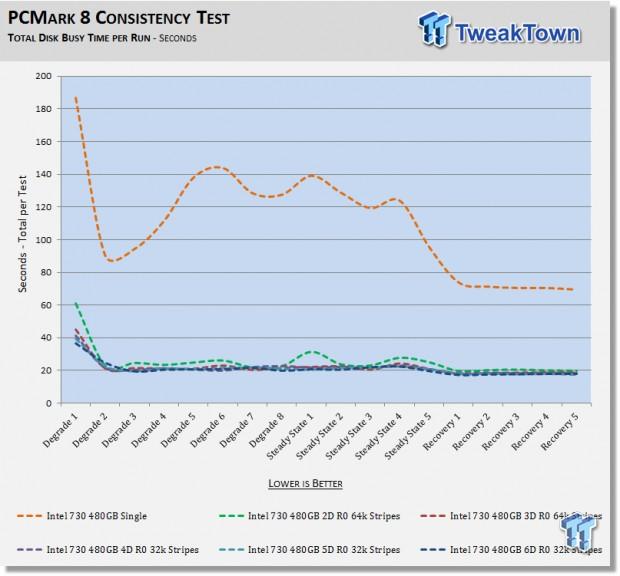
When latency is low, disk busy time is low as well. In a steady state, a 730 array spends up to seven times less time working than a single 730 with the exact same workload.
Data Written
We measure the total amount of random data that the drive/arrays are capable of writing during the degradation phases of the consistency test. The total combined time that degradation data is written to the drive/arrays is 470 minutes. This can be very telling. The better the drive/array can process a continuous stream of random data, the more data will be written.
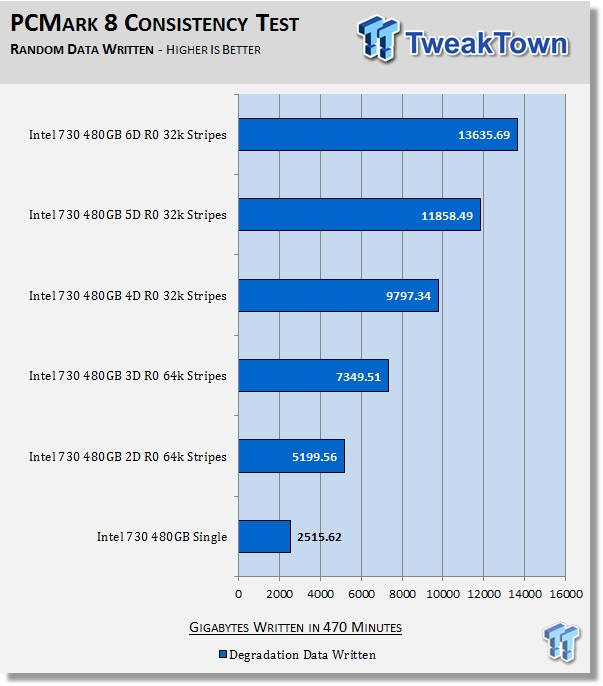
This data shows an aspect of performance that typical benchmarks simply cannot. Even though we are handicapped by our Lynx Point chipset's limited sequential bandwidth, we observe perfect scaling from 1-6 drives, culminating in our 6-drive 3-terabyte array delivering a massive thirteen thousand six hundred gigabytes of random data written in 470 minutes.
Gratuitous Benchmarking
This is where we show you what our arrays performance looks like when powered by the fastest operating system for SATA based storage ever made; Windows Server 2008. This is the exact same hardware just an OS change. This is our 6 drive array with 32K stripes.
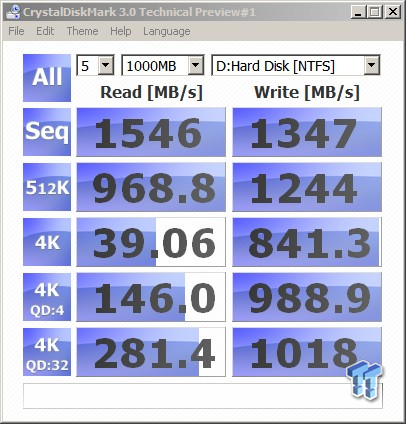
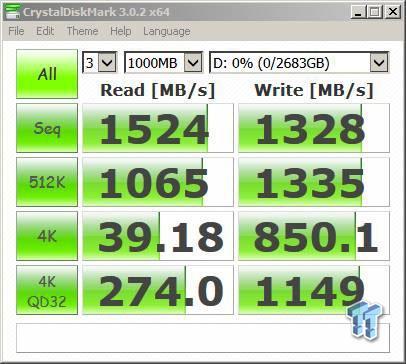
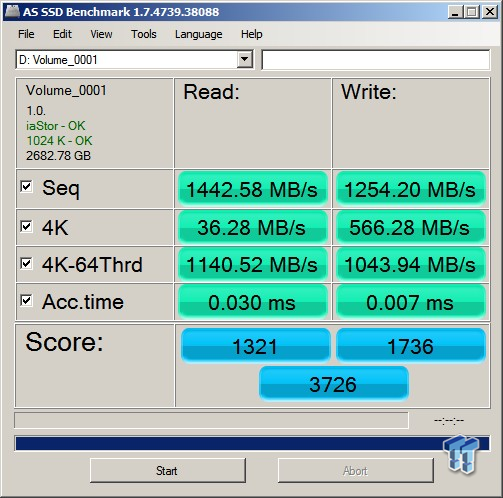
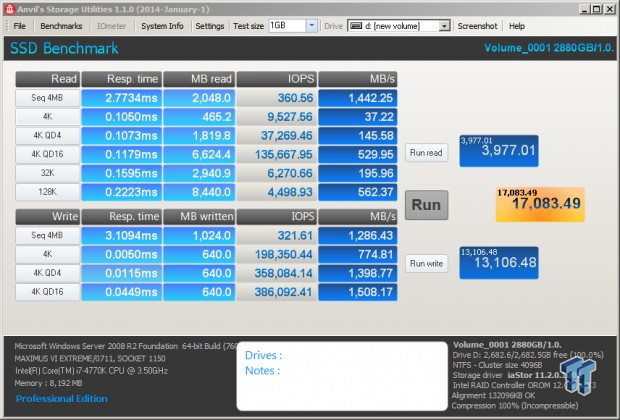
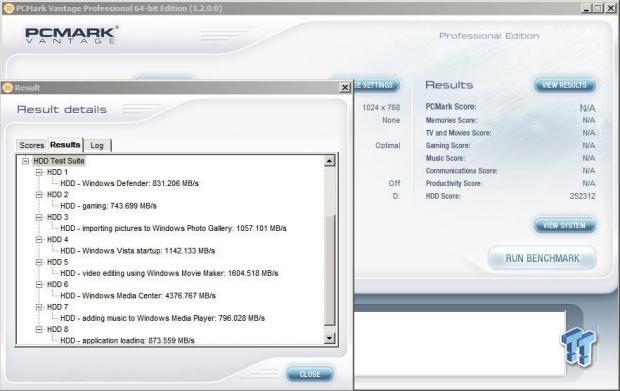
You can't get performance like this from Windows 8 or 8.1 you can get very close with Windows 7, but nothing performs quite as good as Server 2008 when it comes to SATA based storage. 4K write performance is vastly superior on Server 2008 and Windows 7 in comparison to Windows 8 or 8.1. It's really no wonder that a lot of review sites have stuck with Windows 7, it makes their benchmarks look better.
Final Thoughts
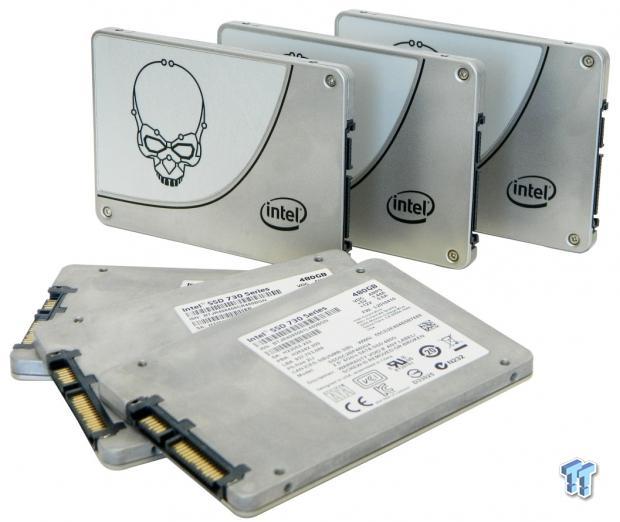
Solid state storage is the most important performance component found in a modern system today. Without it, you do not even have a performance system.
It's easy to see why Intel's 730 is our current RAID champion. When it comes to the ultimate OS disk it has to be SATA RAID; a single SSD or current PCIe drives just cannot deliver performance that is enthusiast class in an OS environment. Most enthusiasts probably don't know this so it's our job to inform you.
When choosing SSD's for a RAID array, the drives that perform best in a single drive scenario do not translate directly to the drives that perform best in a RAID 0 array. SSD's with enterprise DNA like Intel's 730 in particular; come alive when utilized in RAID 0 delivering performance that far exceeds what SSD's with consumer DNA are capable of delivering in RAID 0.
It goes even deeper when we take an array and subject it to steady state testing. Suddenly arrays that have the same performance in an FOB state, deliver vastly different performance in a steady state. A steady state is eventually where every flash-based storage device is going to settle into and remain, so how a drive/array performs in a steady state is the single most important bit of information you need to know when choosing your next SSD. We wrote between 20 and 30 terabytes of data to each of our test drives, or approximately 150 terabytes combined to obtain our steady-state results. Our extended testing alone took approximately 81 hours to complete.
Intel designed their DC S3500 SSD for the data center where RAID scaling, endurance and steady state performance are paramount. The 730 is a DC S3500 on steroids. The 730 retains the DC S3500's enterprise DNA and brings it to the enthusiast sector. Intel's 730 is the real deal, it just takes a RAID 0 array to really bring out the inner beast that's capable of dominating the competition.
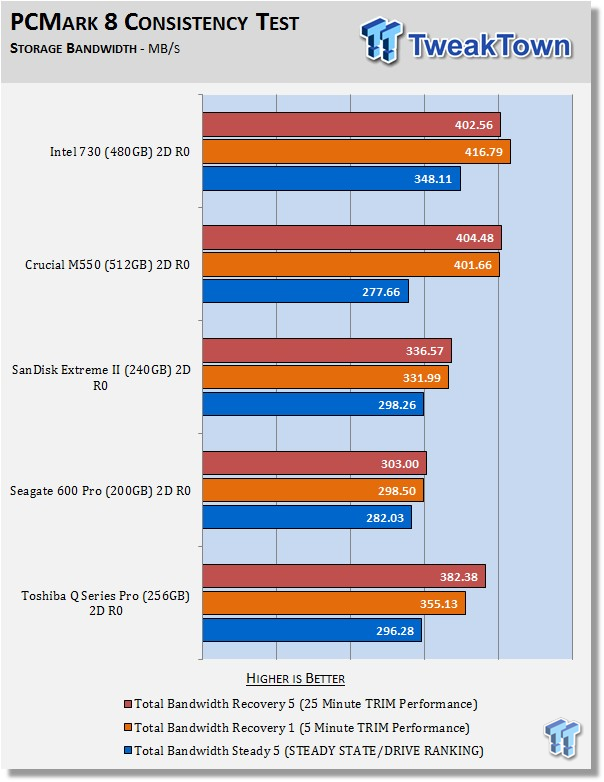
RAIDing two or more drives together provides you with storage that takes performance to the next level and is something I recommend you try. Think of it as the SLI of storage. Once you go RAID, there's no going back!
PRICING: You can find Intel's 730 (480GB) for sale below. The prices listed are valid at the time of writing but can change at any time. Click the link to see the very latest pricing for the best deal.
United States: The Intel 730 (480GB) retails for $445.00 at Amazon.
Canada: The Intel 730 (480GB) retails for CDN$660.23 at Amazon Canada.
Australia: The Intel 730 (480GB) retails for $638.99 AUD at Mighty Ape Australia.
New Zealand: The Intel 730 (480GB) retails for $689.99 NZD at Mighty Ape NZ.

